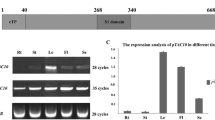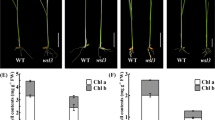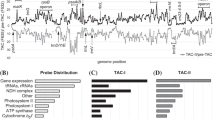Abstract
The nucleic acid binding protein Whirly1 of barley has been located to both chloroplasts and the nucleus of the same cell. Immunogold labelling furthermore showed that in vivo Whirly1 does not strictly co-localize with DNA in chloroplasts, while it is closely associated with DNA in the nucleus. High-resolution imaging of Whirly1-GFP and PEND-RFP fusion proteins revealed that only a minor part of Whirly1 co-localizes with nucleoids. The co-localization with nucleoids is in accordance with the detection of Whirly1 in a conventionally prepared fraction of the transcriptionally active chromosome (TAC). By further purification and enrichment of transcriptional activity Whirly1, however, was lost from the TAC fraction. Knockdown of Whirly1 in transgenic barley plants had neither impact on transcription of selected protein coding genes nor on genes coding for ribosomal RNAs or tRNAs. The results of RIP-chip experiments showed that barley Whirly1 as its maize orthologue associates with a set of intron containing plastid RNAs. Taken together, the results suggest that plastid-located Whirly1 functions primarily in RNA metabolism rather than as a DNA binding protein.






Similar content being viewed by others
Abbreviations
- TAC:
-
Transcriptionally active chromosome
- RIP-chip:
-
RNA co-immunoprecipitation and chip hybridization
- sRNAP:
-
Soluble RNA polymerase
References
Bogenhagen DF, Rousseau D, Burke S (2008) The layered structure of human mitochondrial DNA nucleoids. J Biol Chem 283:3665–3675
Bradford MM (1976) A rapid and sensitive method for the quantification of microgram quantities of protein utilizing the principle of protein-dye binding. Anal Biochem 72:248–254
De Santis-Maciossek G, Kofer W, Bock A, Schoch S, Maier RM, Wanner G, Rüdiger W, Koop HU, Herrmann RG (1999) Targeted disruption of the plastid RNA polymerase genes rpoA, B and C1: molecular biology, biochemistry and ultrastructure. Plant J 18:477–489
Dehesh K, Klaas M, Häuser I, Apel K (1986) Light-induced changes in the distribution of the 36000-Mr polypeptide of NADPH-protochlorophyllide oxidoreductase within different cellular compartments of barley (Hordeum vulgare L.). I. Localization by immunoblotting in isolated plastids and total leaf extracts. Planta 169:162–171
Desveaux D, Després C, Joyeux A, Subramaniam R, Brisson N (2000) PBF-2 is a novel single-stranded DNA binding factor implicated in the PR-10a gene activation in potato. Plant Cell 12:1477–1489
Desveaux D, Allard J, Brisson N, Sygusch J (2002) A new family of plant transcription factors displays a novel ssDNA-binding surface. Nat Struct Biol 9:512–517
Desveaux D, Maréchal A, Brisson N (2005) Whirly transcription factors: defense gene regulation and beyond. Trends Plant Sci 10:95–102
Fling SP, Gregerson DS (1986) Peptide and protein molecular weight determination by electrophoresis using high-molarity tris buffer without urea. Anal Biochem 155:83–88
Grabowski E, Miao Y, Mulisch M, Krupinska K (2008) Single-stranded DNA binding protein Whirly1 in barley leaves is located in chloroplasts and nuclei of the same cell. Plant Physiol 147:1800–1804
Gruissem W, Greenberg BM, Zurawski G, Hallick RB (1986) Chloroplast gene expression and promoter identification in chloroplast extracts. Methods Enzymol 118:253–270
Hallick RB, Lipper C, Richards OC, Rutter WJ (1976) Isolation of a transcriptionally active chromosome from chloroplasts of Euglena gracilis. Biochemistry 15:3039–3045
Hensel G, Valkov V, Middlefell-Williams J, Kumlehn J (2008) Efficient generation of transgenic barley: the way forward to modulate plant-microbe interactions. J Plant Physiol 165:71–82
Humbeck K, Quast S, Krupinska K (1996) Functional and molecular changes in the photosynthetic apparatus during senescence of flag leaves from field-grown barley plants. Plant Cell Environ 19:337–344
Igloi GL, Kössel H (1992) The transcriptional apparatus of chloroplasts. Crit Rev Plant Sci 10:525–558
Jeong SY, Rose A, Meier I (2003) MFP1 is a thylakoid-associated, nucleoid-binding protein with a coiled-coil structure. Nucleic Acids Res 31:5175–5185
Krause K, Krupinska K (2000) Molecular and functional properties of highly purified transcriptionally active chromosomes from spinach chloroplasts. Physiol Plant 109:188–195
Krause K, Kilbienski I, Mulisch M, Rödiger A, Schäfer A, Krupinska K (2005) DNA-binding proteins of the Whirly family in Arabidopsis thaliana are targeted to the organelles. FEBS Lett 579:3707–3712
Krause K, Herrmann U, Fuß J, Miao Y, Krupinska K (2009) Whirly proteins as communicators between plant organelles and the nucleus? Endocytobiosis Cell Res 19:51–62
Krupinska K (1992) Transcriptional control of plastid gene expression during development of primary foliage leaves of barley grown under a daily light-dark regime. Planta 186:294–303
Krupinska K, Apel K (1989) Light-induced transformation of etioplasts to chloroplasts of barley without transcriptional control of plastid gene expression. Mol Gen Genet 219:467–473
Krupinska K, Falk J (1994) Changes in RNA-polymerase activity during biogenesis, maturation and senescence of barley chloroplasts. Comparative analysis of transcripts synthesized either in run-on assays or by transcriptionally active chromosomes. J Plant Physiol 143:298–305
Lakhani S, Khanna NC, Tewari KK (1993) Nascent transcript-binding protein of the pea chloroplast transcriptionally active chromosome. Plant Mol Biol 23:963–979
Lichtenthaler HK (1987) Chlorophylls and carotenoids: pigments of photosynthetic biomembranes. Methods Enzymol 148:350–382
Maréchal A, Parent J-S, Véronneau-Lafortune F, Joyeux A, Lang F, Brisson N (2009) Whirly proteins maintain plastid genome stability in Arabidopsis. Proc Natl Acad Sci USA 106:14693–14698
Meier I, Phelan T, Gruissem W, Spiker S, Schneider D (1996) MFP1, a novel plant filament-like protein with affinity for matrix attachment region DNA. Plant Cell 8:2105–2115
Mullet JE (1988) Chloroplast development and gene expression. Ann Rev Plant Physiol Plant Mol Biol 39:475–502
Pfalz J, Liere K, Kandlbinder A, Dietz K-J, Oelmüller R (2006) pTAC2, -6, and -12 are components of the transcriptionally active plastid chromosome that are required for plastid gene expression. Plant Cell 18:176–197
Poulsen C (1983) The barley chloroplast genome: physical structure and transcriptional activity in vivo. Carlsberg Res Commun 48:57–80
Prikryl J, Watkins KP, Friso G, van Wijk KJ, Barkan A (2008) A member of the Whirly family is a multifunctional RNA- and DNA-binding protein that is essential for chloroplast biogenesis. Nucleic Acids Res 36:5152–5165
Saski C, Lee SB, Fjellheim S, Guda C, Jansen RK, Luo H, Tomkins J, Rognli OA, Daniell H, Clarke JL (2007) Complete chloroplast genome sequences of Hordeum vulgare, Sorghum bicolor and Agrostis stolonifera, and comparative analyses with other grass genomes. Theor Appl Genet 115:571–590
Schmitz-Linneweber C, Williams-Carrier R, Barkan A (2005) RNA immunoprecipitation and microarray analysis show a chloroplast Pentatricopeptide repeat protein to be associated with the 5′ region of mRNAs whose translation it activates. Plant Cell 17:2791–2804
Suck R, Zeltz P, Falk J, Acker A, Kössel H, Krupinska K (1996) Transcriptionally active chromosomes (TACs) of barley chloroplasts contain the α-subunit of plastome-encoded RNA polymerase. Curr Genet 30:515–521
Terasawa K, Sato N (2005) Visualization of plastid nucleoids in situ using the PEND-GFP fusion protein. Plant Cell Physiol 46:649–660
Weber P, Fulgosi H, Piven I, Müller L, Krupinska K, Duong VH, Herrmann RG, Sokolenko A (2006) TCP34, a nuclear-encoded response regulator-like TPR protein of higher plant chloroplasts. J Mol Biol 357:535–549
Wessel D, Flügge UI (1984) A method for the quantitative recovery of protein in dilute solution in the presence of detergents and lipids. Anal Biochem 138:141–143
Xiong JY, Lai CX, Qu Z, Yang XY, Qin XH, Liu GQ (2009) Recruitment of AtWHY1 and AtWHY3 by a distal element upstream of the kinesin gene AtKP1 to mediate transcriptional repression. Plant Mol Biol 71:437–449
Yoo HH, Kwon C, Lee MM, Chung IK (2007) Single-stranded DNA binding factor AtWHY1 modulates telomere length homeostasis in Arabidopsis. Plant J 49:442–451
Acknowledgments
We thank Susanne Braun, Marita Beese, Cornelia Marthe and Reik Modrozynski for technical assistance. Christine Desel (CAU Kiel) is thanked for expert guidance in confocal laser scanning microscopy. Anke Schäfer is thanked for helpful ideas and Ying Miao (CAU Kiel) for critical reading of the manuscript and for help in preparation of the figures. Iris Meier (The Ohio State University, USA) is thanked for providing the antibody towards MFP1. We thank the Center of Biochemistry and Molecular Biology (CAU Kiel) for providing the phosphorimaging equipment. This work was supported by grants of the Deutsche Forschungsgemeinschaft (Kr1350/8, Kr1350/9) and an Emmy-Noether stipend to CSL.
Author information
Authors and Affiliations
Corresponding author
Electronic supplementary material
Below is the link to the electronic supplementary material.
Rights and permissions
About this article
Cite this article
Melonek, J., Mulisch, M., Schmitz-Linneweber, C. et al. Whirly1 in chloroplasts associates with intron containing RNAs and rarely co-localizes with nucleoids. Planta 232, 471–481 (2010). https://doi.org/10.1007/s00425-010-1183-0
Received:
Accepted:
Published:
Issue Date:
DOI: https://doi.org/10.1007/s00425-010-1183-0




